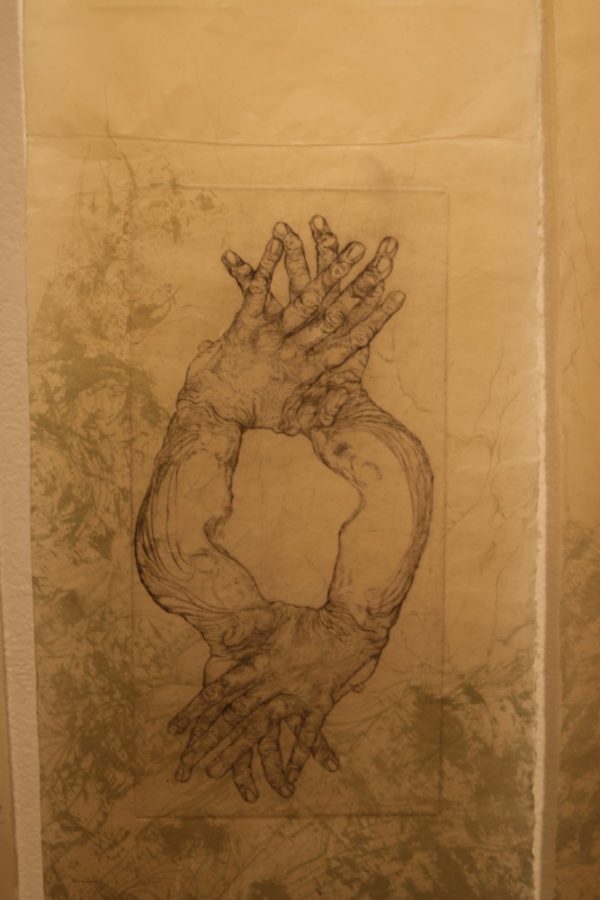Ellery Page is a recent honors graduate from the University of Arizona where she received a Bachelor of Fine Arts in 2D studio art with an emphasis in printmaking and a minor in creative writing. Her honors thesis work focuses on the intersection of neuroscience, art and poetry.
Her exhibition is featured in the Lionel Rombach Art Gallery and is called “Ecological Bodies and the Haptic Home.”
The Daily Wildcat sat down with Ellery Page to discuss her exhibition and her life as an artist.
Daily Wildcat: With the integration of neuroscience in your exhibit, did you take classes in neuroscience? If so, did that contribute to the creation of this project?
Ellery Page: I wanted to go to school originally for neuroscience and I took, I think, a class on it. But I have read a bunch of books, too, that are on neuroscience, like Bessel van de Kolk’s, “The Body Keeps the Score.”
DW: Where did you go to school before transferring to the UA?
EP: I graduated high school here. Then I went to college in Denver for a year and a quarter, and I transferred here. When I transferred here, I changed my major to art, so I didn’t continue doing neuroscience classes.
RELATED: Q&A: UA Director of Bands is a recognized guest at Carnegie hall
DW: Why did you change your major to art?
EP: Well, I got freaked out about chemistry. I had to retest into it and I just did not want to at all. Then, I accidentally fell in love with printmaking. I moved back home and I was really freaked out about going to school. So, I took a semester off, and then I freaked out about doing nothing, so I got three jobs and took some classes at Pima. One of those classes was printmaking. I just ended up going to shop every day from eight to three and then going to work. I just loved it.
DW: Have you been doing 2D art throughout your life?
EP: Yeah. My mom even admitted at one point that we were her artistic experiments, so I mildly blame my parents. I have always been doing it, but I never thought that’s what I would do in college. That kind of happened accidentally.
DW: Is all of your art research-based like your exhibition or does it come from somewhere more personal?
EP: I don’t think it is universally true for art, but I think that the work that I want to share does come from research. The other thing that I want to do is become a tattoo artist. So, like, that art would be for people who want the thing designed for them. It is not sharing that art with the public. I think it’s because I don’t want to talk about my personal self or identity. I think I want to talk about things that are collective issues or changes in perspective. I think those are the things I find most interesting to share.
DW: What is your definition of art and what does it mean to you?
EP: I think art for me means something that is impossible. By which I mean something that goes beyond. The sum of the parts go beyond the parts because you can never charge like an hourly wage to the hours you spend doing anything. Everything will take ten times longer than you think it will. And I think to some degree that is what I find beautiful about art. I think art can also be movement. A lot of contemporary art is moving towards these social change operations or reflections. I mean that to some degree is also an impossible thing.
DW: How did you learn about this theory of Internal Family System, or the psychological theory that each individual is comprised of a collective of selves, that you based your work on?
EP: I’ve always been interested in how the brain works. Part of that does come from having a mother with [post-traumatic stress disorder] and a dad who had some sort of brain incident that changed his brain somehow. My mom was always super off and my dad was super distant. They are extremely opposite. That’s one of the reasons I was always interested in it. That’s why I did the research and that is how I found out about the multiple selves.
I think there are a lot of different cool and interesting things that everyone realizes should be common knowledge when they go through any sort of psychology course or reckoning of some new endeavor of self reflection. It definitely started with me trying to understand the world around me. I think my mom is also a big inspiration because she is a complex and wonderful human who has gone through a lot of PTSD-related treatments and/or reactions. Its top-down (talking therapy), bottom-up (body-to-mind, yoga), and then drugs (pharmaceuticals).
DW: How does it feel to be in the gallery?
EP: It feels awesome. I have had artwork in a café before, which was cool. It’s nice to see people interacting in front of your work. But having a space to which is dedicated for people to think about it and have that layer of respect in the atmosphere of the work is close to disbelief.
Follow Mikayla on Twitter















